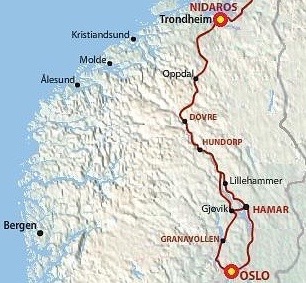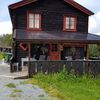5.5.2017 | 13:55
Svolítiđ um Ólaf konung og leiđina mína.
Ég set hér inn smá upplýsingar sem ég fann á netinu um ţessa gönguleiđ og Ólaf konung. Ţetta er nú kannski meira fyrir mig til ţess ađ hafa hér í blogginu mínu,en e.t.v. hafa einhverjir gaman af ţessu líka.![]()
![]()
Leiđin um Guđbrandsdalinn er lengsta pílagrímaleiđin í Noregi og var á miđöldum ađalleiđin milli Oslóar og Ţrándheims (Niđaróss). Leiđin er vel merkt og býđur uppá fallega náttúru um sveitir, ţorp og bći eftir ţví sem ég hef lesiđ.
Á ţeirri leiđ sem viđ ćtlum ađ ganga, sem er kölluđ vesturleiđin getum viđ heimsótt fćđingarstađ Ólafs helga og örugglega marga fleiri áhugaverđa stađi, og ţegar til Lillehammer er komiđ sameinast vestur og austurleiđirnar í eina. Og leiđin liggur svo yfir Dovre fjöllin allt til Ţrándheims og ef allt gengur vel mun ţetta taka rúmlega mánuđ.
Og hér fyrir neđan eru upplýsingar af vefnum á ensku um Olav konung.
The Norwegina king Olav II Haraldsson was born in 995 as a son og the Viking king Harald Grenske, who was the great grandson of Harald Fairhair.
This was highly advantageous in a time when the country had several small kings and earls, because direct lineage from Harald Fairhair gave the right to inherit the Norwegian throne.
Only 12 years old Olav was introduced to the life as a Viking at sea. His mother, Ásta sent with him the experienced Viking Rane, who became an importand teacher for the young boy.
Olav became a successful Viking chief, who was an alliance with several of the rulers of Europe, but he also had dangerous enemies. King Ethelred got back his country and king Olav was richly rewarded.
Another of king Olav´s allied was the Duke Richard II of Normandy. 19 years old Olav stayed in Rouen, France for many months at the Duke´s court. Though Christianity had been introduced to many places in Norway and King Olav Haraldsson probably knew about this new faith, it was during his stay in Normandy that he was taught Christianity by the Duke´s own brother, Archbishop Robert of Rouen, and was babtized in Rouen 1014.
He came back to Norway with the vision and the call to unite his kingdom to become one Christian country under a new Christian legislation.
During the year 1015/16, he was elected king all over Norway and the "things" which were the Viking´s form for democracy. Free men who owned their land were able to vote. In 1016 Olav was hailed as king at Oyrething in Trondheim. He was then the first to be elected as king over the whole country. During this procedure the king also introduced a Christian legislation, which was fully adopted in 1023 at Mosterthing.
During his 15 years as king of Norway, Olav experienced great progress for his project in the country, but also some resistance from important people who made an alliance with the Danish king. Olav had to flee Norway in 1028 and spent a couple of years in Novgorod at the court of Yaroslav I, Grand Prince of Rus(sia), who was not only his brohter-in-law, but also the foster father of his son, Magnus the Good.
1030 king Olav had a dream which he interpreted as a call to go back home and fight for his country. He arrived at Stiklestad with a small army and was killed at a battle there.
The St.Olav´s saga, writthen by the Icelandic historian Snorri Sturluson, tells about miracles that occurred at the b attle scene and later around the king´s grave in Trondheim.
People started to think that he was a holy man and one year later they convinced the bishop to open the grave. The king looked like he had been sleeping, his hair and nails had grown, his skin was fresh and a wonderful fragrance came up from the coffin. The king was declared a martyr and a saint in the year 1031. The relics were placed in the church and the pilgrimages to the holy king´s relics started immediately.
In 1153 the archbishopric of Nidaros was established by the Pope and the first archbishop, Oystein, started the building of the magnificent cathedral of Nidaros in Trondheim. Archbishop Oystein had studied in France and England and was familiar with the architecture of the European cathedral. He brought both the knowledge and stonemasons with him to Trondheim. Archbishop Oystein was an important person for the venetation of St.Olav. He wrote a book about the life and miracles of St. Olav: "Passio et miracula beati Olavi". This book was spread and copied all over Northern Europe and we can still find some copies, among them in libraries in France and Oxford, England.







Bćta viđ athugasemd [Innskráning]
Ekki er lengur hćgt ađ skrifa athugasemdir viđ fćrsluna, ţar sem tímamörk á athugasemdir eru liđin.